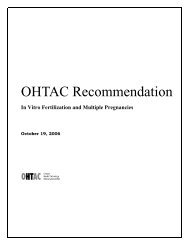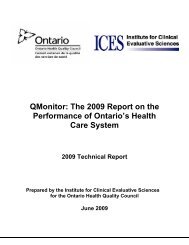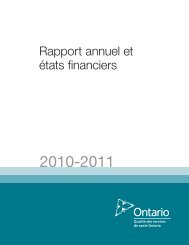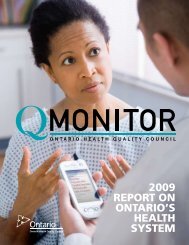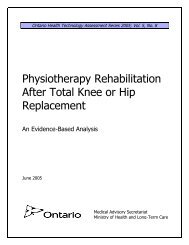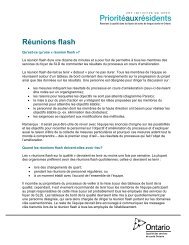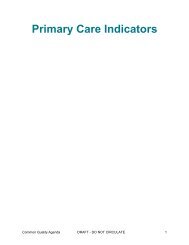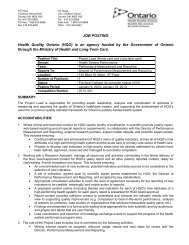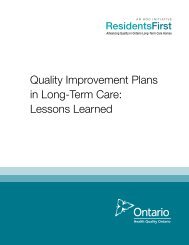Measurement for Quality Improvement - Health Quality Ontario
Measurement for Quality Improvement - Health Quality Ontario
Measurement for Quality Improvement - Health Quality Ontario
You also want an ePaper? Increase the reach of your titles
YUMPU automatically turns print PDFs into web optimized ePapers that Google loves.
Sampling Approach<br />
The measurement consisted of six weekly data collections of 25 patients<br />
each. The patients were sampled in several ways:<br />
5 patients per day <strong>for</strong><br />
5 days of the week.<br />
The patients must be<br />
consecutive and at<br />
least one day must<br />
be a weekend day;<br />
25 consecutive<br />
patients regardless<br />
of any specific day;<br />
excpet that it must<br />
include some<br />
weekend admissions;<br />
If there are fewer<br />
than 25 admissions<br />
<strong>for</strong> a week, the total<br />
admissions <strong>for</strong> the<br />
week should be<br />
included in the sample.<br />
OR<br />
OR<br />
Time was measured from the “decision to admit” to the arrival of the patient<br />
in the inpatient room. The destination could not be a “holding area” but had<br />
to be a real inpatient bed. The sample collection was done in real time. So, a<br />
data collection process had to be created by members of the team that were<br />
collecting the data. In this example, the collections had to be done weekly<br />
and summarized as the percentage of patients in the sample that achieved<br />
the goal <strong>for</strong> that week. Six weeks of data had to be collected and six data<br />
points placed on a run chart.<br />
MEASUREMENT: RUN CHARTS<br />
Why Use Run Charts?<br />
There are many ways that data can be presented to tell the story of a project<br />
or improvement. Whether you use histograms, pie charts or run charts, the<br />
intention is the same: to gain new knowledge and to engage the audience,<br />
whether they are leaders, staff or customers. However, some graphical<br />
representations can be misleading.<br />
Figure 1<br />
><br />
Figure 1 is an example of work<br />
by an improvement team <strong>for</strong>med in<br />
response to complaints from staff<br />
about delays in processing test<br />
results. This chart demonstrates the<br />
length of time (in hours) that it took<br />
<strong>for</strong> test results to be completed<br />
and received by staff. The graph<br />
demonstrates the changes<br />
measured at Week 4 and Week 11.<br />
During Week 4 (that is, four weeks<br />
after the team was <strong>for</strong>med), the<br />
team collected data to confirm<br />
or deny the complaints they were<br />
hearing. The data show that the<br />
turnaround time was eight hours,<br />
unacceptable by any standard. At<br />
Week 7, after the solution design<br />
process, the team tested a change.<br />
Measuring again during Week 11,<br />
they found that the turnaround time<br />
was now three hours. The reduction<br />
in cycle time from eight hours<br />
to three hours is significant and<br />
represents a 62.5% improvement.<br />
<strong>Measurement</strong> <strong>for</strong> <strong>Quality</strong> Improvment| <strong>Health</strong> <strong>Quality</strong> <strong>Ontario</strong> 11




